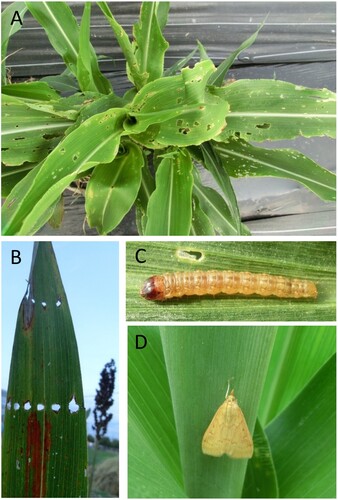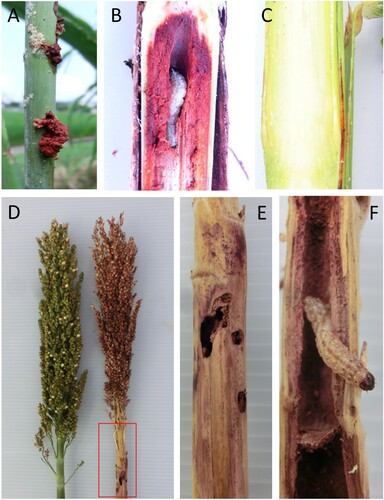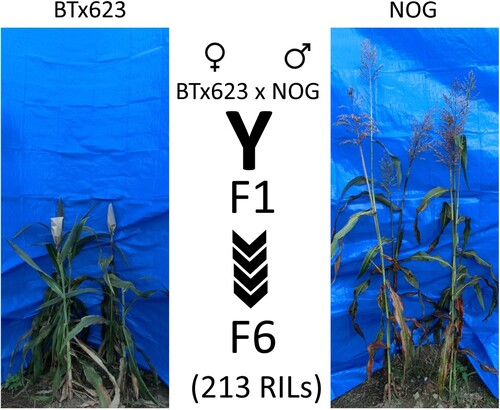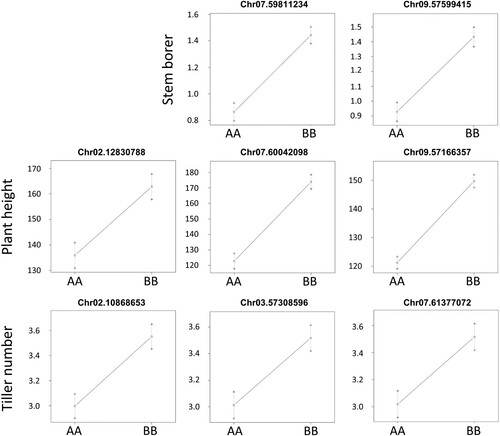Figures & data
Table 1. Summary of QTL with LOD > 3 in sorghum RILs (2016–2018).
Figure 1. Leaf damage on field sorghum during 2016. Sorghum seedlings were transplanted in field plot and observed for herbivores and damage. (A) Leaf damage caused by chewing herbivores on young plants. (B) ‘Shot hole’ damage caused by stem borer during young leaf rolled stage and before moving to stem. (C) Caterpillar of the most abundant chewing herbivore Asian corn borer (O. furnacalis). (D) Adult moth of the same species.

Figure 2. Stem and panicle damage on field sorghum. Field plants were observed for stem and panicle damage and stem borer presence. (A) Displaced purple pigmented pith in stem. (B) Caterpillar of Asian corn stem borer (O. furnacalis) in stem of sorghum showing purple colored internal gallery. (C) Clean/un-attacked section of stem. (D) Effect of stem borer on panicle and grain development and formation of dead hearts; red square area is further depicted in (E), (F). (E) Entry/exit holes of the larval stage of stem borers. (F) Stem borer damage in sorghum stem with caterpillar of Asian corn borer (O. furnacalis). Photos taken during 2016–2018 seasons.

Figure 3. Quantification of sorghum damage caused by Asian corn borer. Sorghum plants of varieties BTx623 and NOG were scored for damage from O. furnacalis in two successive seasons. (A) Total leaf area damage (%) in three assessments (21st July, 4th August, 30th August 2016). Note that percentage of leaf area damage is reduced in time due to plant growth. (B) Entry holes, stem galleries, and larvae per tiller in BTx623 and NOG plants in two field seasons. Asterisks denote statistically significant differences between cultivars at P < .05 (*) and P < .01 (**) using Student’s t-test; ns indicates not significant.

Figure 4. Scheme of RILs used for QTL detection. Parental sorghum plants of NOG (male) and BTx623 (female) were crossed to produce F1 plants. The F1 generation and recurrent self-pollination were used to get F6 (for RAD-sequence and mapping population) and higher generation seeds to establish 213 RILs for this field study. The actual number of RILs in each year varied, as shown in text, because of lines that did not establish in some years.

Figure 5. QTLs detected in sorghum RILs in 2016 season. Field data from RILs were used to get QTLs: (A) Heading time (HT) QTL on chromosome 8. (B) Plant height (PH) QTLs on chromosomes 7 and 9. (C) Tiller number QTLs on chromosomes 2, 3, and 7. (D) Stem borer QTLs on chromosomes 7 and 9. Gray horizontal lines show LOD = 3; red lines show significant LODs levels based on a permutation test with 1000 iterations.

Figure 6. Effector plots for growth and herbivory-related QTLs in sorghum RILs. Effector plots of different herbivory and growth QTLs show that BB genotype (NOG) is associated with higher trait values (SB, PH, and TN) as compared to AA genotype (BTx623).

Table 2. Correlations between stem borer (SB), plant height PH), tiller number (TN), and heading time (HT) in RILs in 2016.
